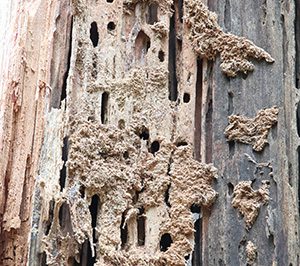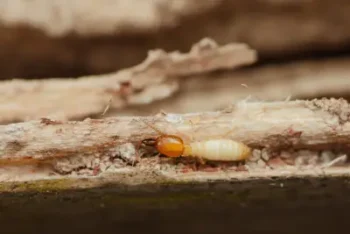
This is our quick answer. If you’re looking for more in-depth information, click to jump to our full answer – how to prevent carpenter ants in your house
Have you ever dealt with carpenter ants? These small wood-destroying ants can cause big headaches for homeowners, and infestations are stubborn. The key to protecting your home is learning how to prevent carpenter ants. Fortunately, there are some simple things you can do around the house that will reduce your risk substantially.
Here’s what we recommend:
- Eliminate moisture and rotted wood
- Manage firewood and yard debris
- Seal entry points
- Maintain your landscape
Listen Now for Carpenter Ant Prevention Tips
This audio covers all you need to know!
Need Help From an Ant Exterminator?
Dive Deeper – How to Prevent Carpenter Ants
If you’ve had a carpenter ant infestation before, we doubt you want to go through that again. With over half a century of ant control experience, Suburban Exterminating is here to offer some of our expertise to protect your home from carpenter ants.
What Attracts Carpenter Ants?
 Carpenter ants dispatch scouts in search of resources; these scouts will venture up to 1000 feet from the colony in their search. Once your home is marked as a resource-rich environment, you might soon find yourself facing an infestation. Any of these factors may help attract carpenter ants to your home:
Carpenter ants dispatch scouts in search of resources; these scouts will venture up to 1000 feet from the colony in their search. Once your home is marked as a resource-rich environment, you might soon find yourself facing an infestation. Any of these factors may help attract carpenter ants to your home:
- Moist wood or water damage
- Excess vegetation and dead trees near your home
- Cracks and crevices in the building’s exterior
- Food spills and crumbs
Now that we understand what attracts carpenter ants, let’s dive deeper into the best ways to prevent them.
The Best Ways to Prevent Carpenter Ants
#1. Eliminate moisture and rotted wood
Carpenter ants don’t eat wood like termites do; they excavate it to build their nests. They are strongly attracted to damp, decaying wood because it’s soft and much easier for them to tunnel through. By fixing leaks and removing water-damaged wood, you’re eliminating their preferred nesting material and making your home far less inviting.
- Promptly repair any water leaks from plumbing, roofs, or gutters.
- Ensure crawl spaces, basements, and attics are well-ventilated to prevent moisture buildup.
- Remove and replace any water-damaged or decaying wood in and around your home.
#2. Manage firewood and yard debris
Piles of firewood, old stumps, and rotting logs are perfect, ready-made homes for carpenter ant colonies. Storing these materials away from your foundation creates a crucial buffer zone. This makes it much harder for a colony nesting in your woodpile to discover and migrate into the wooden structures of your house.
- Store firewood off the ground and away from your house.
- Remove dead trees, stumps, and rotting logs from your property.
- Keep a clear perimeter around your foundation, free of wood debris and mulch.
#3. Seal entry points
A carpenter ant colony can’t infest your home if it can’t get inside. These ants are opportunistic and will exploit any available opening. Sealing cracks in the foundation, gaps around utility pipes, and ensuring windows are properly screened creates a physical barrier, effectively blocking their primary routes of entry from the outside.
- Thoroughly inspect the exterior of your home for cracks and crevices in the foundation, around windows, and where utility lines enter. Seal any openings you find.
- Install or repair screens on all vents and windows.
- Ensure weather stripping and door sweeps create a tight seal.
#4. Maintain your landscape
Tree branches or overgrown shrubs that touch your house act like highways for ants. They allow carpenter ants to easily bypass the ground and gain direct access to your siding, roofline, and windows, where they can find small openings to enter. Trimming back vegetation eliminates these bridges and keeps foraging ants on the ground and away from your home’s structure.
- Trim back tree branches and shrubs so they do not touch your house, as these can serve as bridges for ants.
- Keep your yard clear of debris that could harbor ant colonies.
How to Tell the Difference Between Carpenter Ants and Termites
Carpenter ants and termites are both known for damaging wooden structures – and both species have swarming phases. There are many similarities between carpenter ants and termites, but there are also some key differences to help you tell them apart:
- Waist: Carpenter ants have a clearly defined waist area; termites have a thick waist.
- Antennae: Carpenter ants have bent antennae; termites have straight antennae.
- Wing Length: On a carpenter ant, the front wings are noticeably longer than the back wings. Termites have wings of equal length.
- Damage: Carpenter ants excavate wood, leaving behind a smooth appearance. They do not eat wood. Termites eat wood, leaving behind a more hollowed-out, rough texture, with more extensive damage.
- Sightings: Carpenter ants are often seen out in the open, especially at night. Termites are less likely to be exposed, as they spend most of their time underground or within walls or wooden structures.
How Much Damage Do Carpenter Ants Do?
Carpenter ants are destructive, but not as destructive as termites. Unlike termites, carpenter ants do not consume the wood. However, the damage can become quite extensive if the infestation is ignored.
Can You Have More Than One Carpenter Ant Colony in Your House?
Yes. A carpenter ant colony may establish satellite colonies when the primary colony becomes too large or crowded – or if a group of ants is cut off from the main colony, perhaps as a result of a previous unsuccessful treatment. Carpenter ant colonies can have as many as a few thousand individuals.
Suffolk and Nassau County’s Carpenter Ant Experts
As the area’s go-to carpenter ant experts, we understand the stress and damage these pests can cause. If you suspect an infestation or just have questions, don’t hesitate to get in touch. Our experienced team is here to provide you with effective solutions and peace of mind.
Protect your home and invest in your peace of mind by choosing our expert services today. For reliable ant control services, call us now.
Back to Ant Exterminators – Control – Removal

